 |
American History
The Cristeros – Part II
Long Live the Virgin of Guadalupe!
Luiz Siqueira Campos
Viva Cristo Rey! Viva la Vírgen de Guadalupe! “Long live Christ the King! Long live the Virgin of Guadalupe!” These battle cries gave unity and force to the Mexican Cristeros to enter into combat, to resist torture or to defy death.
Viva el Demonio! “Long live the Devil!" was shouted in response by their opponents, the soldiers of the Federal army of Mexico, dominated by atheistic officers.
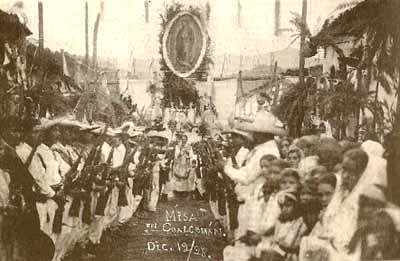
Cristeros celebrate Our Lady of Guadalupe Feastday on December 12, 1928 |
Still today, after almost 80 years since the Cristiada - the epic fight of the Mexican Catholic Cristeros for their faith in the fields and hills of Jalisco, Mijoacan and other States across Mexico – it is astonishing to see the degree of hatred shown by the enemies of the Holy Church in those dire days. To understand such a hatred, we must recall the words of God the Father to the Serpent in Genesis: “I will put enmities between thee and the woman, and thy seed and her seed: she shall crush thy head, and thou shall lie in wait for her heel” (3:15)
Not only then, not only in Mexico, but in every time and place when Catholics are truly devoted to the Mother of God, the Devil and his cohorts try to destroy them. But in the case of the Mexican Cristiada, an explanation of the name Guadalupe can explain the particular ferocity of this hatred against the Church.
The siege of Mexico City in 1521 marked the Spanish conquest of the Aztec Empire. But the spiritual conquest still remained, and this was a task too great for mere men, even the fervent Franciscans who began the evangelization of Mexico. The small group faced multiple obstacles: the bad example of many of the Spaniards moved by greed, power and lust was certainly one. But another less perceptible but more profound barrier was the feeling of many Indians that Catholicism was the white man’s religion, that it did not really belong to them.
In 1531, twelve years after the landing of Cortez, and ten years after the Conquest, the Franciscans could report the baptisms of about 200,000 Indians, only a small fraction of the whole population.
Our Lady appears to Juan Diego
On Saturday, December 9, 1531, shortly before dawn, an Indian peasant, Juan Diego of the village Cuauhtitlan, was on the way to Tlatelolco for morning Mass, which he attended every day that he could. Like Simon of Cyrene on his way to Jerusalem, Juan Diego was a simple man going about his daily duties, trying to live according to the will of God.
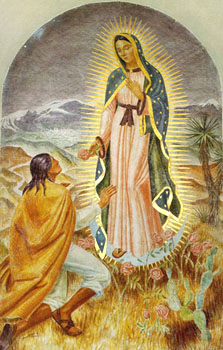
Our Lady appears to Juan Diego |
What Christ’s Mother willed was for Juan Diego was for him to become her instrument to open a miraculous spring of graces for the New World, which flows until today with inexhaustible generosity.
As he crossed the summit of the hill known as Tepeyac, he heard singing and saw a brilliant white cloud. Astonished, he stopped, and he heard a voice from above calling him: “Juanito, Juan Dieguito!” [Little Juan, little Juan Diego!] Before the cloud, he saw a beautiful Lady of extraordinary grandeur, who told him to come nearer. Marveling at her garments that shone like the sun and transformed the rocks where her feet rested into a ringlet of precious stones, he fell to his knees.
In his own native language, she asked him, “Juanito, the most humble of my sons, where are you going?”
He answered he was going to hear Mass at Tlatelolco.
She said him: “I am truly the ever virgin Mary, Holy Mother of the True God through whom everything lives, the Creator of all things, Lord of heaven and earth. I desire that a sanctuary be erected in this place so I may in it I may show and give all my love, compassion, help, and protection to the people.”
She charged him with the mission to go to the palace of the Bishop of Mexico and tell him it was her desire to have a sanctuary built there.
A failed mission and second try
Juan Diego went to Mexico City to speak to Bishop Juan de Zumarraga, a Franciscan Friar who had recently been appointed the first Bishop of Mexico. Bishop Zumarraga received and heard the poor Indian benevolently, but not surprisingly he doubted his words. So he invited Juan Diego to come again with a clearer plan from the Lady.
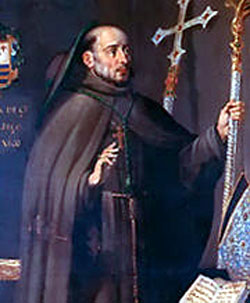
Bishop Zumarraga, the first Bishop of Mexico |
On the way home, at the same spot, the Heavenly Lady awaited him. Juan Diego told her what had happened and asked the Holy Virgin to send someone else who would have a better chance of being heard. “I am no one,” he told her. He did not understand that it was exactly this humility that moved the Queen of Heaven to choose him.
She answered: “I earnestly implore you to go in my name and make known my wish in its entirety, that he must begin to construct the sanctuary that I am requesting of him. Tell him once again that I, the ever-virgin Mary, Holy Mother of God, have sent you.”
The next day, Sunday, Juan Diego went again to hear Mass and to accomplish the will of Our Lady. After Mass, he went to the Bishop’s house, and with great difficulty managed to speak again with him. This time, the Bishop – more impressed but still doubting – demanded some concrete proof of the apparition. With sorrow in his heart, the emissary of Our Lady left him.
The Bishop ordered two servants to follow him to see where he went and to whom he spoke. Near the bridge to Tepeyac, however, Juan Diego disappeared to their sight. He was with Our Lady, who promised to give the sign the Bishop had requested the following morning.
The miracle of the roses and tilma
But the next day, Monday, Juan Diego’s uncle, Juan Bernardino, became seriously ill, and he spent the day caring for his uncle. On Tuesday morning, his uncle believed he was reaching his last hour and asked his nephew to bring a priest to anoint him. The troubled emissary of the Virgin judged that the eternal destiny of his uncle’s soul took precedence over his mission to see the Bishop. So he went to summon a priest to hear the confession of his dying uncle.
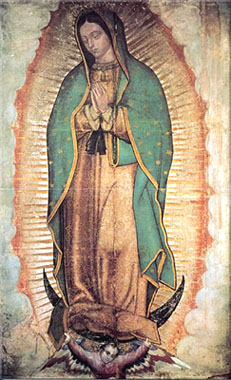
The miraculous tilma of Our Lady of Guadalupe. Know more here |
To avoid meeting the Virgin, he took a different route. But she descended from the hill to intercept him, saying, “What is there, my son the least of all men? Where are you going?”
She told him not to be afflicted by his uncle’s illness, because he was already cured. He should climb to the top of the hill, she instructed him, and cut and gather the flowers blooming there and bring them to her.
The hill was a desert place and it was winter, but Juan Diego did as she ordered. He found the hilltop covered with beautiful Castilian roses of the sweetest fragrance. He gathered the flowers, and the Virgin herself took them from him and arranged them in his tilma.
The poor Indian, the ambassador of the Queen of the Universe, then went to present to the Bishop of Mexico the proof that his mission was authentic. It was not easy to be received again by the Prince of the Church, but the simple Indian persisted, saying that he had the needed proof.
When he was finally admitted, he told the Bishop all that happened and opened his cloak. The roses cascaded to the floor, and there on his tilma was stamped the precious Image of the ever-virgin Mary, the Blessed Mother of God, appearing in the same manner Juan Diego had seen her. The portrait still exists today as it was then, in brilliant color, the cactus fiber untouched by the passage of centuries.
The name of Guadalupe
When the Virgin appeared to Juan Diego’s uncle and healed him, she told him that she desired this Image of herself to be called Blessed Virgin Mary of Guadalupe.
Why should she choose the same name of a popular shrine in Spain that had no particular relation to the New World? Usually Our Lady wants to be known by the name of the place or region where she appears (Lourdes, Fatima).
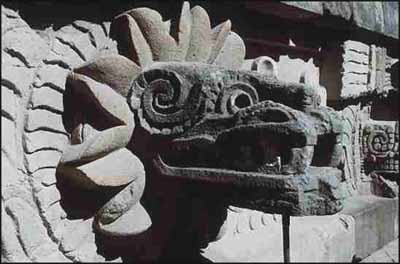
The serpent god Quetzalcoatl was crushed by Our Lady when the Indians converted to Catholicism |
It has been speculated that Our Lady actually said the Aztec word in the Nahuatl language of coatlaxopeuh, which is pronounced "quatlasupe" and sounds similar to the Spanish word Guadalupe. This word means to crush or stamp the serpent. Therefore, Our Lady wanted to tell the Mexican natives that she was the one "who crushes the serpent.” The Indians would understand the meaning of this because one of their most important gods was Quetzalcoatl, a serpent.
This fact could explain the incredible hatred that the forces of hell revealed in the persecutions four centuries later toward the Mexican Church and the Indians converted by Our Lady of Guadalupe. Instead of destroying the faith, however, these persecutions would cause many loyal Catholics, the Cristeros, to take up arms and write with their blood one of the most epic chapters of History, the Mexican Cristiada.
The warriors of Our Lady
This apparition of the Virgin Mary to Juan Diego unleashed an outpouring of graces among the Indians of Mexico unknown in History. Wherever the missionaries went, the Indians flocked to them to be baptized in overwhelming numbers. In the records of the Franciscans, we find reports of one priest baptizing 14,200 Indians in five days. There was no force, no coercion. The Indians sought out the priests and asked to enter the Faith.
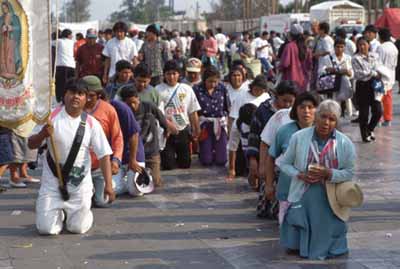
An enduring bond: Mexicans on pilgrimage to the Basilica of Our Lady of Guadalupe |
When Juan Diego and Bishop Zumarraga died in the spring of 1548 – they died within a few days of each other – the total number of baptized Indians in Mexico was approximately nine million. That is to say, in 17 years, Our Lady did what was impossible for even the most dedicated missionary: she accomplished the spiritual conquest of Mexico. It was she – the Virgin of Guadalupe – who won their hearts and souls to bring them to Christ. One can see that a spark of this first fire of love for Mary remains to this day as an indestructible bond between the Virgin of Guadalupe and the Mexican people.
The Mexican soul, which in the last article we saw was characterized by both the grandeur and violence inherited from the Aztecs, as well as the heroism and spirit of challenge that came from the Spaniards, now received new characteristics that define that people. What are they? Simply said: the extraordinary predilection of Our Lady for them, the capacity to quick assimilate the Catholic spirit, and an instinctive openness toward the supernatural.
These are reasons that help explain why Mexico was the first pedestal for Mary, the place that she chose to shine over the three Americas - and from there, over the whole world. The soul of this rude but favored people was indelibly stamped with a call to follow the Virgin Mary as she showed herself on the tilma of Juan Diego. They are called to be the warriors to help her crush the head of the serpent.

Posted February 20, 2009

Related Topics of Interest
 The Cristeros I: The Spaniards Land in Mexico The Cristeros I: The Spaniards Land in Mexico
 Catholicism in Colonial America Catholicism in Colonial America
 La Conquistadora: Our Country's Oldest Madonna La Conquistadora: Our Country's Oldest Madonna
 Ven. Antonio Margil of Jesus: Apostle of New Spain and Texas Ven. Antonio Margil of Jesus: Apostle of New Spain and Texas
 The Appeal of the Stones at San Juan Capistrano The Appeal of the Stones at San Juan Capistrano
 The First Thanksgivings Were Catholic The First Thanksgivings Were Catholic
 Defending the Crusades Defending the Crusades

Related Works of Interest
|
|
History | Home | Books | CDs | Search | Contact Us | Donate

© 2002-
Tradition in Action, Inc. All Rights Reserved
|
 |
|